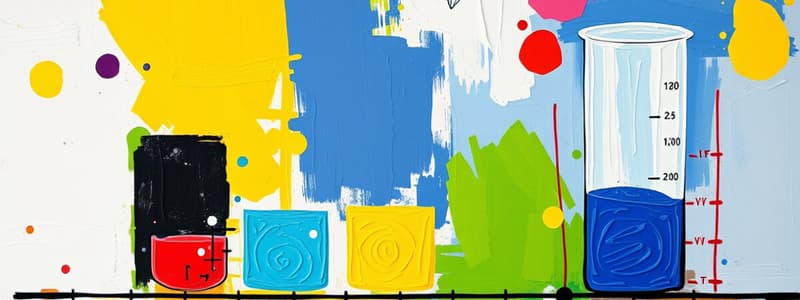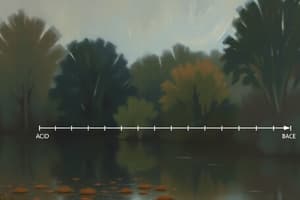Podcast
Questions and Answers
A pH of 7 is a ______ solution.
A pH of 7 is a ______ solution.
neutral
Solutions with a pH below 7 are considered ______.
Solutions with a pH below 7 are considered ______.
acidic
A ______ is any compound that forms OH– ions in a solution.
A ______ is any compound that forms OH– ions in a solution.
base
Buffers are substances produced by cells that prevent sharp, sudden changes in ______.
Buffers are substances produced by cells that prevent sharp, sudden changes in ______.
Acids have a pH of ______ 7.
Acids have a pH of ______ 7.
Flashcards are hidden until you start studying
Study Notes
The pH Scale
- The pH scale measures hydrogen ion (H+) concentration in a solution.
- It ranges from 0 (highly acidic) to 14 (highly basic).
- A pH of 7 is considered neutral; pure water has this pH.
- Solutions with pH below 7 are acidic, indicating higher H+ ion concentrations.
- Solutions with pH above 7 are basic, indicating lower H+ ion concentrations.
Acids
- Acids are compounds that release H+ ions when dissolved in a solution.
- Acidic solutions have a higher concentration of H+ ions compared to pure water.
- Acids are characterized by a pH lower than 7.
- Common examples include lemon juice, tomato juice, carbonated beverages, and vinegar.
Bases
- Bases are compounds that generate hydroxide ions (OH–) in a solution.
- Basic solutions have a lower concentration of H+ ions relative to pure water.
- Bases exhibit a pH higher than 7.
- Notable examples include ammonia, soaps, bleach, and sodium bicarbonate.
Buffers
- Human cells typically maintain a pH between 6 and 8 for optimal functioning.
- Deviations in pH can impede essential chemical reactions within cells.
- It is crucial for cells to regulate their pH levels.
- Buffers are biological substances that help stabilize pH, preventing rapid changes.
Studying That Suits You
Use AI to generate personalized quizzes and flashcards to suit your learning preferences.




